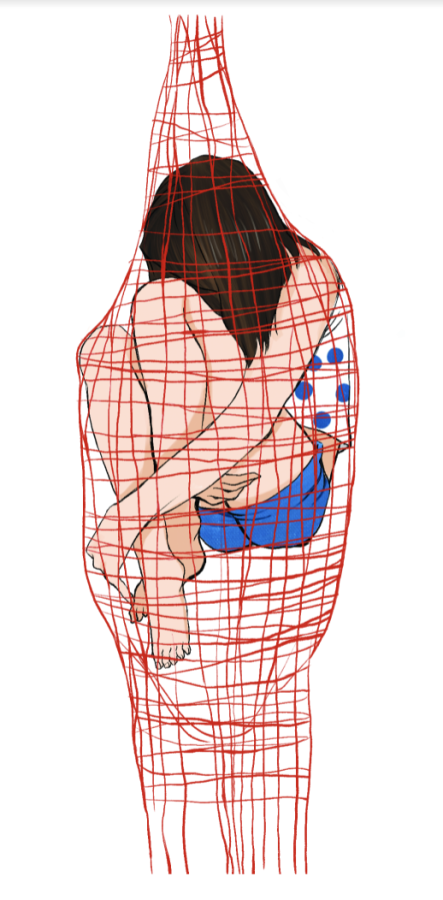The Race to Nowhere
As dark streaks of mascara trail down my cheeks, a torrent of glistening tears begin to swell running down my ashamed cheeks, blurring my vision from the reality of a grade I never wanted to see, imprinted on top of the paper, forcing my eyes to close as if it was the end of the world.
February 8, 2023
Once Upon a Time … I was perfect among a sea of millions chasing the same incessant dream as I, of fleeting prestigious Ivy Leagues, with sky-high GPAs and towering amounts of extracurriculars. From a glimpse of light at the crack of dawn to the clock hitting 1 a.m. outside in the pitch dark, exhausted teenagers from all over the nation gaze blankly at their half-written paper illuminating from a computer screen as math worksheets litter their desks to be finished.
Grasping at the pure thought of sleep, students continuously force their eyes open, dismissing their bodies’ insistent need for rest and instead getting ready for a arduous night ahead.
While eyes begin to strain and students’ heads pound telling them to stop, they simply can not. They can not stop, can not burn out, and can not break under pressure, for fear of failure overshadows everything, including their youth.
While this may seem like an excessive depiction of a high schooler’s routine, according to Researchers.com, 75% of teenagers always or often feel stress derived from academics on a daily basis, becoming consuming in hopes of embodying the ideals of a “perfect student.
As college admissions lower their acceptance rates and heighten their standards, high schoolers begin to feel the overbearing hold academia has more than ever, diluting themselves down to a single grade.
As perfectionism becomes an identity in and out of the classroom for many students, it obscures their opportunity to discover themselves in such a quintessential time as adolescents.
Constantly in an inverse relationship as expectations continue to increase, pressure on oneself also expands, pushing the idea of average out of the frame on a scale of excellence, but at what cost?
Blinded by the desire to prove ourselves to parents, colleges, and others, this fixation on unrealistic standards captures the vulnerability teens face to achieve the unparalleled. Upper school head, Melissa Alkire says, “The collective group mentality that sometimes occurs around the college process can be really toxic because all of a sudden you start doubting what you want and start asking should I want what my next-door neighbor has, should I want that person’s dreams, is my dream enough.“
Suddenly if you fall short of that expectation at any given moment, there is little to no acceptance, as this motivation to become the best only becomes your worst enemy.
Failure is no longer the way we used to know it as the heart of learning, where mistakes are welcome and corrections are supposed to be made, but instead, failure has been depicted as an evil monster in high school we are fearful and cautious of.
However, when teens don’t know how to deal with failure, it becomes fatal, affecting both the mental and physical health of students while also compromising their social life.
As schools continue to put such a heavy emphasis on achieving the best grades, valedictorian, and Summa Cum Laude, students have begun valuing themselves to the letter on their report cards as if an extra “+” determines their worth as teens.
Even if high schoolers have such a profound understanding of complex issues, when all eyes are set on achieving perfection, students begin to struggle to understand who they are once detached from their grades. As individuality becomes even harder to distinguish when groups of students file out of the classroom grumbling at their mistakes, in reality, it might have been a 92%.
But when applying to colleges, it becomes a number game students scramble to collect community service hours from buffering their GPA and SAT scores for admissions.
“I think the hard part is when kids are stretching themselves so far because they feel like they need to compete with some outside standard that they lose the joy, they lose joy in the learning process“ Ms. Alkire says.
When fostered in an environment where constant comparisons between students become prevalent, the need to be the best or achieve something greater leaves zero room to do “average” as greatness becomes the basis of criterion. While this idea of “healthy” competition might be the key for kids to achieve greater lengths, students become inquisitive and try harder through this detrimental social motivation to become the top 1% at school.
Not only seen in and out of the classroom, perfectionism is also integrated into all educational formats fostering these qualities students labor to achieve. “…every college and university receives hundreds of thousands of applications that are all perfect and the colleges have to look and ask if that person is just perfect A’s across and what else is there to this child that makes them interesting, what going to make them a good roommate, what’s going to make them a good citizen, and sometimes students will opt out of those things, in pursuit of that perfect transcript” Ms. Alkire says.
In attempts to attain these perfectionist qualities, the focus on social comparison and development cultivates the salience of self-other evaluations.
Now instead of the light-hearted camaraderie between classmates, it has developed to become an strenuous competition with one goal in mind: college.
As high schoolers traverse through this collegiate rabbit hole, its consuming nature is harmful, especially when students are praised and spend their whole lives toiling for acceptance at a greater expense.
When parents and peers become entranced by the success of top colleges, these impressions and expectations contribute to the underdevelopment of social skills needed to flourish in workplaces. However, when there is a substantial unbalance between extracurricular activities and academics, grades hold much greater significance.
In recent years statistics from the American Addiction Institute report, 88 percent of college students said their life to be full of stress accounting for an increase in mental disorders.
The height of academic pressure, however, doesn’t always equate to better grades and contentment; instead, on the contrary, it results in an “increased prevalence of psychological and physical problems like depression, anxiety, nervousness, and stress-related disorders.”
More recent studies conducted by NYU show a dramatic increase in substance abuse as a method of coping with academic pressure, which The Daily Cougar defines as “an experience in which a student is burdened by the demands of time and energy to achieve specific academic goals.”
But these toxic coping methods and disorders won’t miraculously vanish once a Standford acceptance letter arrives. As colleges throughout the decades have become more and more selective as recent Ivy Leagues have reported their lowest admission rates in their histories.
Dropping to a mere 3.19% acceptance rate, it’s the lowest in Harvard’s 386 years, becoming the norm as students feel the urge to take extreme measures to get their shot.
How much longer do we continue to chase this cynical cycle of perfection? How many more AP courses do we need to take?
How much more can we bear until we burn out? Can we endure it? Can we see the end? As a youth, we are supposed to have fun and learn how to offset the demand of life with the academic pressures we devote so much of our lives to achieve.
However our growth and development are hindered through that process, we learn we are not just numbers but instead individuals with high aspirations disillusioned by the unhealthy validation that comes with academia.

































